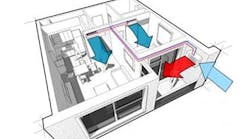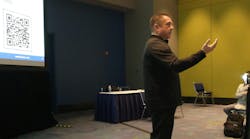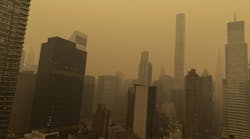Are homeowners, builders, and new homebuyers really concerned about indoor environmental quality?
Just consider the following:
-
Litigation related to moisture and mold contamination in homes is increasing
-
The National Association of Home Builders (NAHB) says homeowner inquiries related to moisture problems account for 30% of the calls NAHB receives
-
The prevalence of asthma is high: the Environmental Protection Agency (EPA) reports 19% of U.S. households have at least one person with asthma
-
Sales of indoor air quality (IAQ) products — including air cleaners, air fresheners, and UV lights — now exceed $1 billion/year. It's a big business, but many products don't offer a fully beneficial solution.
People are jumping on the IAQ bandwagon with all sorts of supposed solutions, but many of those are only bandaids used to cover up the problem rather than address the cause: poor building design.
Role of Ventilation in IAQ
There's much to learn about green building and indoor air quality. It's important that today's HVAC contractor understands the role proper ventilation plays in IAQ, and how ventilation methods can best be combined to serve the homeowner.
If you want to offer green building ventilation solutions, you've got to see the entire picture, and take the entire system into consideration, including the equipment and the occupants. Ventilation is not just about the fan, the duct, or the hood.
“Green building” involves increasing the efficiency with which buildings use and collect energy, water, and materials. These practices are enhanced by improved site selection, building design, construction, operation, and maintenance methods during the entire lifecycle of the home or building. The endgame of all of this activity is to reduce effects on human health and on the environment.
Know What's Green, and Explain It
The American Society of Heating, Refrigerating, and Air-conditioning Engineers' (ASHRAE) Greenguide describes a “green” or “sustainable” building design as one that achieves high performance over the full life cycle of the building in the following areas:
- Minimized natural resource consumption
- Reduced emissions
- Lower discharge of solid waste and liquid effluents
- Maximum quality of indoor environment, including IAQ.
We must also separate green facts from green fiction. Contributing to the confusion is the weak and often varied definition of “green,” just as we saw years ago with “organic” products. Do your research as you consider using green products, and be certain you have an understanding of how the various systems work together. Select the appropriate system for the application, install it correctly, and learn about its components. Test it and commission it before leaving the home, and teach the homeowner how to use and maintain it.
Ventilation Messaging: Make it Visible
HVAC contractors will make great progress with homeowners if they know how to generate a dialogue with them.
“Involvement questions” include: “Does your house ever feel stuffy?” or, “Did you realize that typical home HVAC systems don't include fresh air ventilation?”
Other statements can help the contractor demonstrate the value he or she can provide: “All of our customers' homes are equipped with high efficiency, whole-house, fresh air ventilation,” or, “We include more than a dozen advanced heating and cooling system features to improve comfort and system effectiveness.”
Ventilation a Key to Many Programs
For maximum stability as they “ride the wave” of green building, HVAC contractors must consider how ventilation relates to many key building standards and programs. Here's a look at some of them:
-
EPA's Energy Star with Indoor Air Package Plus specifications were developed based on the best available science and information about risks associated with IAQ problems, and balanced with practical issues of cost, builder production process compatibility, and enforceability. The Indoor Air Package Plus program contains recommendations on best practices related to HVAC systems, including duct installation, whole-house and post spot ventilation, and air filtration. — energystar.gov
-
The National Association of Home Builders (NAHB) is bringing green to the mainstream with the National Green Building Program (NAHB Green) for all homebuilders and remodelers. The coming National Green Building Standard is based on the NAHB Model Green Home Building Guidelines. It's being developed through an American National Standards Institute (ANSI) consensus process, is being prepared by a committee of industry stakeholders, including the NAHB and the International Code Council. The NAHB Research Center is serving as secretary for the consensus-based standard development process. The Standard is expected to be released by ANSI in 2008. — nahb.org
-
The Enterprise Community Partners Green Building Program “Green Communities Initiative” is supported by the USGBC. It's intended to help popularize green building and sustainable development in the affordable housing industry. By 2009, Green Communities Initiative will provide $550 million in grants and equity investment. — greencommunities online.org
-
Southface Energy Institute, Atlanta, GA, promotes sustainable homes, workplaces and communities through education, research, advocacy and technical assistance. Its Earthcraft House division is a residential green building program of the Greater Atlanta Home Builders Association in partnership with Southface. This program serves as a blueprint for energy- and resource-efficient homes. — southface.org
-
The American Lung Association's Health House program provides quality information for homebuilders and homeowners regarding home design, construction, renovation and operation with a focus on healthy IAQ. Health House seeks to build a unique blend of sound medical science integrated with proven building science. Information is presented in a format that's easy to understand. Health House supports HVAC systems designed according to ACCA Manual J. — healthhouse.org
The Importance of ASHRAE 62.2
ASHRAE Standard 62.2 — Ventilation and Acceptable Indoor Air Quality in Low-Rise Residential Buildings — applies to spaces intended for human occupancy within single-family houses and multifamily structures of three stories or fewer above grade, including manufactured and modular houses.
It's essential that contractors who are entering a green training program have an understanding of ASHRAE 62, because virtually all of the national green building programs are based on it, including: LEED for Homes®; the Energy Star with Indoor Air Package Plus; Residential Energy Services Network (RESNET) ratings; National Association of Home Builders Green Standard; numerous state programs; and most weatherization programs.
ASHRAE Standard 62.2 is the only nationally-recognized design standard for residential ventilation. It's also the design standard for the engineering community. If engineers are called upon to justify what they've done, they can fall back to Standard 62.2 as the only nationally-recognized standard. It's based on building science and the accumulated knowledge of the ASHRAE 62.2 committee.
You can view ASHRAE 62.2 by visiting ashrae.org/standards.
All green building standards have ventilation requirements, and it's important that HVAC contractors familiarize themselves with ANSI/ASHRAE 62.2 2007 and Energy Star with Indoor Air Package Plus. Bad ventilation installations can cause problems and result in expensive callbacks, which erase your profits.
Snake oil or bandaid solutions will come back to bite you. Good ventilation and green ventilation installations can be profitable, easy to install, and will result in satisfied customers.
Paul Raymer is the chief investigator for Heyoka Solutions, Falmouth, MA, a company he co-founded in 2006 for the development of comfortable, sustainable, affordable, fully-integrated building products, and small, modular, zero-energy homes. His latest book is Residential Ventilation Handbook: Ventilation to Improve Indoor Air Quality. He can be reached by email at [email protected].
Don Stevens is national research and development manager for Panasonic Home and Environment Company, Secaucus, NJ. He is a former chairman of the Home Ventilating Institute, and is vice chair of the ASHRAE Standing Standards Project Committee (SSPC) 62.2. He can be reached by email at [email protected].
This article is based on the presentation, Understanding Ventilation in Green Building Programs, which Paul Raymer and Don Stevens gave at HVAC Comfortech 2008, held in Atlanta, GA, September 10-13, 2008. For more information about HVAC Comfortech 2009, which will be held in Nashville, TN, September 23-26, call 216/931-9550, or visit hvaccomfortech.com.
Visit contractingbusiness.com for a list of ventilation and green building resources. Keyword “ventilation.”
The Green Staircase
Incorporating Energy Star, the Indoor Air Package Plus, and accepted green building methods make it easier to be green.
ENERGY STAR
Energy Efficiency
- envelope
- distribution
- equipment
- lighting
- appliances
INDOOR AIR PACKAGE PLUS
IAQ and Durability
- moisture and mold
- soil-gas control
- pest management
- HVAC
- combustion safety
- materials
- commissioning
GREEN BUILDING
Resource Efficiency
- site planning
- water
- materials
- waste management
- renewables
Whole building ventilation example: 800 sq. ft. two bedroom apartment
-
2 bedrooms assumes 3 occupants
-
(3 occupants × 7.5 cfm/occupant) + (800 ft.× 1/100 sq.ft.) = 31 CFM required airflow.
Using Table 1, go across the table at <1500 ft., and down from ‘2-3 bedrooms’ to find 45 CFM required airflow.








